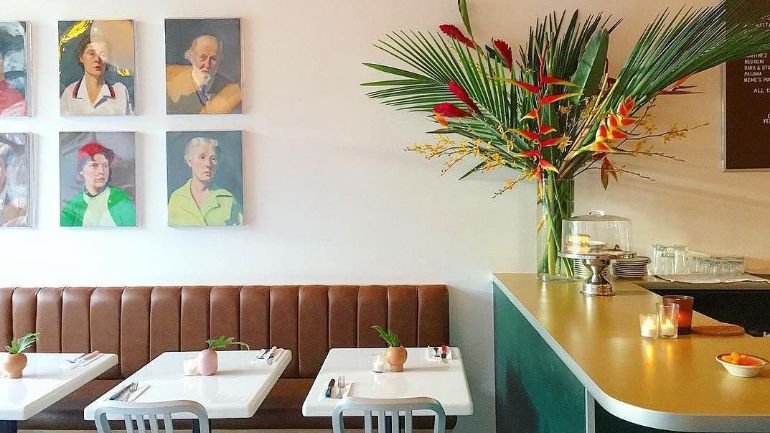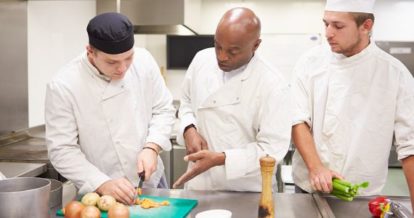A labor shortage and rising labor costs? Sounds like New York has a perfect storm brewing.
Hikes in minimum wage have had a big impact on the restaurant industry as a whole, but New York City has been hit especially hard. In the wider state, the wage raise applies to over 750,000 food service workers and the businesses that employ them.
But first, let’s set the scene.
At the beginning of 2018, hourly minimum wage rose in 18 states across the U.S. In 2019, it’s set to rise (again) in more than 20 states. While a bump in salary can increase staff productivity and help reduce your employee turnover, it can also impact your bottom line.
To understand these effects fully, we produced a research report called the State of Rising Minimum Wage For Restaurants. Our research in this report showed that labor costs can account for as much as 30% of a restaurant’s annual expenses. Anything above 30% and restaurants can see shrinking profits.
Of restaurant owners surveyed for this report, 77% have seen some effect on profits due to minimum wage obligations. But most restaurant owners feel they can handle the increase in labor costs without taking drastic measures.
The top three ways they’re adjusting to minimum wage increases?
- Raising menu prices
- Cutting operating hours
- Letting go of staff
But prices can only go so high before you turn off customers. Cutting operating hours gives you less time to serve customers and recoup costs. Reducing employees’ working hours and letting go of staff can be bad for morale – and can seriously impact customer service.
Focusing back on NYC, the city rang in the new year with an increase to $15 for minimum wage workers at large employers (of 11 or more). Minimum wage workers at small employers (of 10 or less) saw an increase to $13.50, with the full raise to $15 coming by the end of 2019.
So how is the city that never sleeps dealing with rising minimum wage?
Let’s take a closer look.
Minimum Wage in NYC Isn’t the Same for Everyone
First of all, if you’re running a restaurant, in NYC or elsewhere, you need to hire several different kinds of employees who fall into different salary categories.
Here are top 10 things you need to know about minimum wage in NYC:
- Minimum wage is higher in NYC proper than in other areas of New York.
- Minimum wage in NY differs for operations that are considered “large” (11 or more employees) and “small” (10 employees or fewer).
- Employees in small operations earn less per hour.
- Minimum wage is actually made up of two parts for tipped employees: 1) a minimum wage set by either the federal, state, or local government, and 2) a cash tip portion that brings the total wage up to regular minimum wage rates or greater.
- For their tipped employees, using what’s called the tip credit allows employers to count cash tips toward the minimum wage obligation.
- In NYC, tipped workers are paid a $10 wage by the employer and must make up the remaining $5 with their earned tips to reach the $15 minimum. If an employee falls short, the employer must make up the difference.
- A compulsory service charge (such as 15% automatically added to the bill) is NOT considered a tip, but can be used to meet the minimum wage requirement.
- Pooled tips must also be sufficient to meet an employee’s minimum wage or the employer must make up the difference.
- Minimum wage is different for tipped and non-tipped employees, and different again for salaried and non-salaried workers.
- The restaurant industry has the largest portion of tipped workers in the US (63%) but isn’t the only industry to employ this type of worker.

Snapshot of Minimum Wage in NYC
How has minimum wage changed in New York City over the past few years?
Let’s look at hourly-wage workers, fast food staff, and tipped employees – all common in restaurant staffing.
General Minimum Wage (for line cooks, porters, chefs)
Large Employers (11 employees or more):
- 2016: $11
- 2017: $13
- 2018 and beyond: $15
Small Employers (10 employees or less):
- 2016: $10.50
- 2017: $12
- 2018: $13.50
- 2019: $15
Minimum Wage for Fast Food Workers
- 2016: $12
- 2017: $13.50
- 2018 and beyond: $15.00
Minimum Wage for Tipped Food Service Workers
Large Employers (11 employees or more):
- 2016: $7.50
- 2017: $8.65
- 2018-2021: $10.00
Small Employers (10 employees or less):
- 2016: $7.50
- 2017: $8.00
- 2018-2021: $10.00
The Real-Life Effects of Rising Minimum Wage in NYC
How does a minimum wage increase to $15 really affect restaurant operators?
We interviewed two TouchBistro customers to share their realities of minimum wage hikes.
Bill Clark is the co-owner of MeMe’s Diner in Brooklyn, and Raymond Azzi is the co-owner of two popular vegan eateries, Double Zero and Bar Verde, in East Village.
Double Zero opened in January 2016 and has seen two successive minimum wage increases since then. They weathered the first increase without laying off any staff, but did have to reduce employee hours and raise menu prices to make up for it.
“After the first minimum wage increase, we had to raise our prices 15 to 20% and trim down the hours we were giving employees,” says Rammond. “The second time, we couldn’t increase prices any more.”
The latest minimum wage increase to $15 has been a tougher go. Between the two restaurants, Raymond trimmed the team by 5 to 7 staff members, impacting both front of house and back of house positions.
Because of those staff cuts, Raymond has stepped in as general manager and nows works the floor – in addition to overseeing administrative tasks like marketing and accounting. He’s now scrutinizing his POS labor reports to keep costs in check – especially overtime.
Plus, with the recent minimum wage increase, Raymond has also had to raise hourly wages of his employees who were already making $15 an hour to make sure he was being fair.
“You now have porters making the same wage as line cooks, but line cooks are sometimes doing up to five different jobs and require certain skill sets,” he says. “As a result, incremental wage increases to the tune of $2 to $3 an hour were required to ensure I wouldn’t lose my staff. It’s really hurting our profit margins and finances.”
Raymond is also trying to control costs by diversifying his suppliers, checking every single invoice to compare prices without sacrificing quality.
MeMe’s Diner, which opened its doors in November 2017, made a conscious decision to pay their staff above minimum wage, even though they have until the end of 2019 to bring minimum wage to $15. They did, however, increase menu prices and are keeping a close eye on cost of goods sold (COGS) during menu planning.
Both restaurant owners have said that they analyze sales reports carefully, on a weekly basis, always on the lookout for best sellers, high-margin dishes, and underperformers. Detailed point-of-sale reports are invaluable. They provide sales insights, manage inventory levels, and track profits.

Your Bottom Line Starts with Your Front Line
Restaurants are in the hospitality business, which means they’re ultimately in the people business. Customer loyalty can be a tricky beast and, since there are no shortage of other options, restaurants must make the customer experience a top priority.
Seasoned restaurant operators know that understaffing can hurt the bottom line by way of bad customer experience – there aren’t enough employees to provide the same level of service.
But understaffing doesn’t just mean fewer staff; it can also mean inexperienced staff. Maintaining reliable, well-trained employees and qualified, skilled workers, should help keep operations efficient and customers happy.
Restaurants with multiple locations can consider cross training staff to reduce overhead. This way, people can do more jobs, and you need fewer employees overall. The upside for your staff is that your team has more shifts available to them – which hopefully translates into lower turnover.
Many experienced restaurant managers have also increased wages above the minimum wage to show an investment in their staff and safeguard against employees quitting. Staff turnover is notorious in the restaurant business, topping out at over 72%. And dependable employees are the key to a providing a consistently positive dining experience.

Want to get your restaurant summer ready?
Using Technology to Boost Profit
Restaurant technology is your best bet to hedge against eroding profits.
Two key ways technology helps restaurants stay profitable are:
- Better reporting and control to keep costs in check
- Identifying new opportunities to make money
Here are three simple ways your POS can help you cut costs:
1. Reduce Staff During Slow Periods
You may be scheduling too many employees during slow times – and may not even know it. Review the labor reports on your POS to track when staff are truly needed. Even small shift changes can add up to substantial cost-savings over time.
2. Compare Your Labor Reports Against Last Year
Compare labor reports against last year, looking at seasons, holidays, and times of day, to make sure you schedule staff accordingly. Do you need the same number of bartenders you had last year during NYC Pride?
Using technology to control labor costs is just smart management. But, surprisingly, our 2018 research report shows that 39% of restaurateurs are not leveraging their POS for labor data insights. Strong reporting tools allow you to optimize staff scheduling so you can control costs. If you’ve got ‘em, use ‘em!
Be sure to combine those reports with other key performance indicators (KPIs) such as sales per labor hour, hourly sales, and average ticket size. Many operators simply look at their daily sales, but factoring in that additional data will make you a master scheduler.
3. Control Your Inventory
Inventory management can be time-consuming and tedious, but the return is worth it. Using your POS to properly track inventory will reduce food waste and save you money. If you’re a restaurant who serves fish neatly filleted, don’t waste those bones. Turn them into a delicious fish stock and put on a soup special!
All of these things add up to tighter operations, less overhead, and higher profits.

Here are two ways your POS can identify ways to increase profits:
1. Focus on Upsells and Offers
POS reports can arm you with information about your most profitable menu items. Have your staff promote those dishes, offer any extras that go with them (paid modifiers like gravy, extra bacon, etc.), recommend wine or beer pairings, and encourage dessert orders – with two forks for sharing.
Run POS reports to determine when your restaurant is less busy and what you sell then. Is your pre-dinner hour especially slow? Add Happy Hour specials to draw in more business. Is lunchtime quiet? Offer a prix fixe menu and promise to have your lunch patrons in and out in one hour.
2. Inventory Overages: Reduce or Reuse
POS inventory reports can track your ingredient supplies down to the teaspoon.
With that information, you have two choices:
- Adjust your weekly vendor orders to reduce food waste
- Repurpose ingredients into a secondary menu
Many restaurants are choosing the second option and starting “ghost kitchens.” That’s a virtual restaurant, separate from your bricks and mortar, that offers up a different, take-out only menu during your off-peak times when your back of house staff is already on shift.
An NBC survey of 100 of New York City’s top customer-rated Seamless and GrubHub restaurants found that more than 10% of them came from ghost restaurants.
Professional tip: TouchBistro’s POS Heat Map report tells you when your peak and off-peak times are. Combine that with Sales by Order Type for a breakdown of your sales by delivery, online ordering, dine-in, etc. and you’ll know exactly what dishes sell best – at what time of day and through which order method.
A ghost kitchen is a creative way to introduce or test new menu items, or find economies in shared inventory by creating dishes that use the same ingredients you’re already purchasing for your restaurant. For example, a sushi restaurant can very easily create a poke menu.
Take this one step further by offering your secondary menu through a separate channel, like online ordering or delivery only. You’ll maximize on-hand inventory and create additional revenue.
Minimum wage will continue to rise in the coming years, and restaurants will continue feeling the squeeze. But the long-term impact doesn’t have to lead to shrinking margins and closure – you just have to plan, control costs, and take a smart, tech-based approach to remain profitable.

Want to get your restaurant summer ready?
Download your free employee handbook template
Sign up for our free weekly TouchBistro Newsletter







